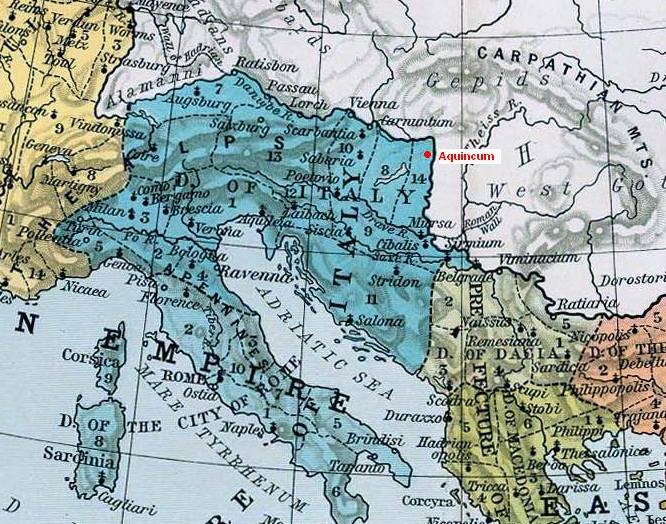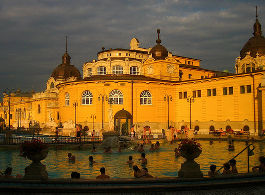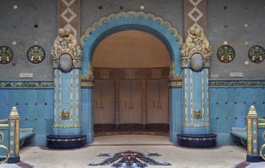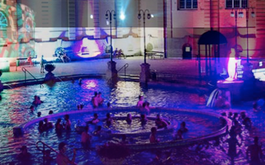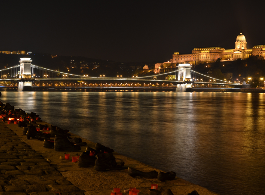Hungary the Land of Spas and Budapest the City of Spas
Visiting Budapest can not be complete without visiting one of the Budapest baths. There are thermal baths, open air spa baths, lidos and pools in big green parks all over the city. How come?

Gellert Bath – Joe Mabel Photography
Why is Budapest the City of Spas?
Hungary is full of wonderful spas, thermal waters, and both Budapest and the countryside (e.g. Zalakaros, Hévíz) can boast about superb thermal baths (at truly affordable prices). Little wonder that in 1937 Budapest officially became the City of Spas at the first World Federation of Hydrotherapy and Climatotherapy, for short FEMTEC conference held in Budapest with the participation of 37 countries.
Even the first president of the World Federation of Hydrotherapy was a Hungarian man (József Ferenc) Unfortunately, during the communist era, spa baths were very hard to be accessed for western travelers daring through the iron curtain. But since 1989, Hungary has been open to everybody who wishes to relax in its thermal baths, and huge investments are being made into the versatile utilization of geothermal energies.
As the old Roman proverb says:
“Balnea, vina, Venus corrumpunt corpora sana,
Corpora sana dabunt balnea, vina, Venus.”“Baths, wine and love spoils healthy bodies;
but baths, wine and love make up healthy bodies.”
(this ancient Roman proverb was well-known in the Turkish ruled Hungarian city of Eger in the in the Middle Ages, according to chronicles)
How many spa baths are there in Hungary?
Currently there are about 140 registered thermal baths in Hungary, out of which about 10 spa baths are located in Budapest (Csepel Bath and Lido, Dagaly Bath and Lido, Dandar Bath and Lido, Gellert Baths, Kiraly Baths, Lukacs Baths, Paskal Lido and Baths, Palatinus Lido, Rac Bath, Rudas Bath, Szechenyi Baths, Ujpest Bath) – some are using the same thermal springs. However, according to estimates (sources differ widely), there are about 1300 thermal springs in Hungary (620 wells) – many of which are not simply mineral waters containing magnesium or calcium, etc., but they are proven medicinal waters with various healing properties.
You can see some of the spa baths in Budapest in this nice video:
Why are there so many spa baths in Hungary?
First the Romans, then the Turks have discovered that the area where Hungary is now located is abundant with warm or hot healing waters – some are muddier, others are cleaner, some are good for your legs, arms and joints, others for your lungs, kidney, stomach, etc. Spa waters were recognized by their heat and smell, and soldiers, dervishes, pashas, etc. liked this special luxury – not just for religious but for medical reasons too. But why are there so many of these healing waters? The answer is geothermal energy, i.e. the energy given by the heat of the Earth. This heat preserved in the inner parts of the planet, under the crust, gets to the surface more easily in Hungary as the crust under the country has become thinner over the thousands of years. So much thinner that the average geothermal heat coming from beneath is twice of the European average. Hungary has several geothermal reservoirs, hot springs, more readily available, well before geothermal drilling became a practice. You can find thermal waters under 80% of the Hungarian territory. No wonder, 2008 has been announced as the Year of Waters by the Hungarian Tourism Co.
What are Hungarian spa waters good for?
Of course, over the last 1000-1500 years in the Carpathian basin, people who inhabited these regions have got to know what these waters are best used for to preserve your health. Treating locomotor diseases, stomach complaints are the most typical, but some of the water springs are recommended for gynaecological problems, skin diseases, etc. As thermal waters are not black or white magic, you may wish to check with your doctor if spa baths are recommended for you or not (usually they are not suggested for chronic high-blood pressure, anaemia, during pregnancy, right after heart attacks, etc.).
Remains of the old Spa Culture
Excavations have revealed Celtic and Roman ruins of bath houses, mosaics, remains of frescoes, which show that the Romans used the available spa water resources for heating and bathing alike. Aquincum (literally: Water-city) a military city also inhabited by wine-growers, tradesmen, etc. had bath houses, palaces, amphitheatres, aqueducts, sewers, and it is the most well-known aquacultural memento of the Roman times in Hungary. Originally it served as a border city to protect the outermost territories of the Roman empire. See its location on this reconstructed map (red letter in the upper right part):
Here’s a photo of the mosaics of the Roman bath (made by khoogheem)
Turkish occupation, Turkish Baths
During the Ottoman Turkish occupation (from 1526 to 1699), the Turks have built at least 40 spa baths (or hamam) on the medicinal water springs they have found in Hungary. It was an excellent financial investment – not just today but already in the 16th century. Turkish architectural features (impressive dome, small windows, niches with fountains, etc.) were well preserved, and in the last couple of years considerable investments have been made to reconstruct the beautiful and mysteriously lit Turkish baths. Alas, only a handful of them are operational these days. In Budapest, you will find Rudas Gyógyfürdő (Rudas Spa Bath from the 1550s), Rác Gyógyfürdő (Rác Spa Bath – formerly known in King Matthias time as the Royal Spa – under construction!), Király Fürdő (Király Spa Bath – built in 1565), as well as the historical Császár Fürdő (Csaszar Spa Bath). In the countryside, you can visit the Turkish Bath in Eger (built in 1610-17), or the Turkish Bath (now only functioning as a Bath Museum) in Pécs.
This is a photo of Rudas Fürdő (Rudas Turkish Bath)

and a picture of Király Fürdő (Király Turkish Bath)

Searching For Oil, Finding Water
In the course of the 18-19th century, there were several attempts made to find oil in Hungary, the liquid gold to make profits everyone was hoping for, which often resulted in finding good quality thermal medicinal waters. Hungarians enjoyed them tremendously, but it took many decades to recognize that the thermal baths and geo thermal energies are the golden mines of Hungary. Not only in Budapest, but all over the country of Hungary new spa and medicinal baths were built, e.g. in Zalakaros, Hajdúszoboszló, Sárvár, Hévíz. Needless to say, the most visited thermal bath houses are in Budapest, so if you take a visit in the Hungarian capital, do not miss the “Baths Budapest” item on the itinerary.
